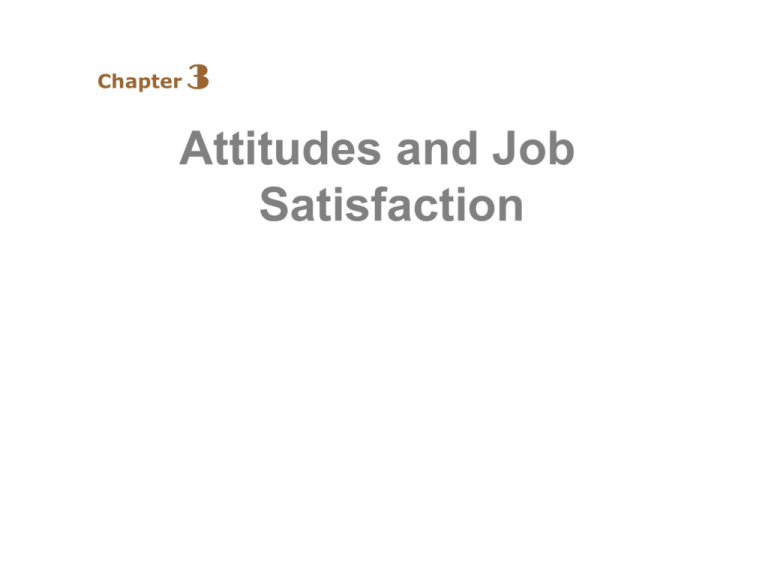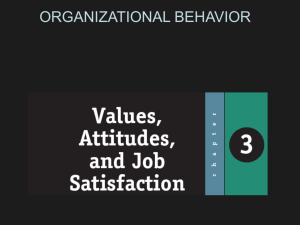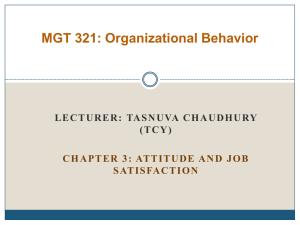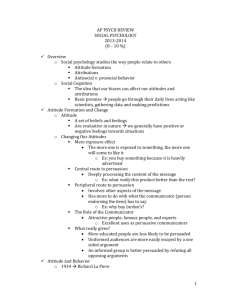Attitudes and Job Satisfaction
advertisement

Chapter 3 Attitudes and Job Satisfaction Learning Objectives Contrast the three components of an attitude. Summarize the relationship between attitudes and behavior. Identify the role consistency plays in attitudes. State the relationship between job satisfaction and behavior. Identify four employee responses to dissatisfaction. Attitude Defined Briefly defined, an “attitude” represents a tendency to respond in a favorable or unfavorable way to persons or objects in one’s environment. For instance, when we say we “like” something or “dislike” something, we are in effect expressing an attitude toward the person or object. Attitude could be defined also as a mental predisposition to act in a particular way towards a person or an object. Some issues that matter in the study of attitudes What are the main components of attitude? How consistent are attitudes? Does behavior always follow from attitudes? What are the main job attitudes? How are employees attitudes measured? What are the importance of attitudes to workplace diversity? Attitudes Attitudes • Attitudes are the feelings and beliefs that largely determine how employees will perceive their environment, commit themselves to intend actions and ultimately behave • Evaluative statements or judgments concerning objects, people, or events. • Less stable than values Cognitive component The opinion or belief segment of an attitude. Affective Component The emotional or feeling segment of an attitude. Behavioral Component An intention to behave in a certain way toward someone or something. Relationship between the components in the Tricomponent Attitude Model Cognition How consistent are attitudes People change their attitudes although attitudes are relatively stable mental predispositions. Sometimes, attitudes change even very quickly as if it does not have any stability. Generally, people seek consistency: – Among their different attitudes, and – Between their attitudes and their behavior When there is inconsistency, people seek to return to a level of equilibrium state. The Theory of Cognitive Dissonance Cognitive Dissonance •Dissonance = Inconsistency or incompatibility •Any incompatibility between two or more attitudes or between behavior and attitudes •Individuals seek to reduce this gap, or “dissonance” Desire to reduce dissonance depends on • Importance of elements creating dissonance • Degree of individual influence over elements • Rewards involved in dissonance Is A Happy Worker A Productive Worker? Over the years, one of the most strongly held beliefs among managers and I/O psychologists is that there is a relationship between a worker’s job satisfaction and his/her job performance. In 60 year’s worth of research I/O psychologists have found highly variable linkages between job satisfaction and job performance. The most recent examination by Timothy Judge and his colleagues suggests a correlation of .30 between satisfaction and performance, a small but meaningful association. Measuring the A-B Relationship Recent research indicates that attitudes (A) significantly predict behaviors (B) when moderating variables are taken into account. A B Moderating Variables • Importance of the attitude • Specificity of the attitude • Accessibility of the attitude • Social pressures on the individual • Direct experience with the attitude Self-Perception Theory Attitudes are used, after the fact, to make sense out of an action that has already occurred. And, B When asked about an attitude toward some object, individuals recall their behavior relevant to that object and then infer their attitude from their past behavior. A! Types of Attitudes Job Satisfaction A collection of positive and/or negative feelings that an individual holds toward his or her job. Job Involvement Identifying with the job, actively participating in it, and considering performance important to self-worth. Organizational Commitment Identifying with a particular organization and its goals, and wishing to maintain membership in the organization (Affective, Normative, and Continuance Commitment) Organizational Commitment Mowday, Steers, and Porter (1982) define OC which has three component – A strong belief in and acceptance of organizational goals and values – A willingness to exert considerable efforts on behalf of the organizations – A strong desire to maintain membership Researchers have confirmed a positive relationships between OC and Job performance, and inverse relationships found with tardiness, absenteeism and turnover. Point-Counter Point Exercise Think about two to three jobs you have had, outside of family chores (Family Business) List the jobs on the top of sheet List down what you really liked about the jobs and what you disliked about the jobs. Find out the commonalities and differences Discuss what managers or supervisors could do to increase the likes and decrease the dislikes. Mangers Can Create Satisfied Employees: What you think ? Types of Attitudes, cont’d. Perceived Organizational Support (POS) Degree to which employees feel the organization cares about their well-being. Employee Engagement An individual’s involvement with, satisfaction with, and enthusiasm for the organization. Attitudes Exercise - Set-Up Situation: You are an expert who has been asked to provide your expertise on the following issue. The Residential Life Department of a large university has been experiencing an usually high rate of turnover among it’s Resident Assistants (RA’s) during the last year. Over 60% of the university’s RA’s have recently left their positions, and with those that remain, poor performance is commonplace. This situation is very troubling, given the costs of training RA’s and of replacing them when they leave. Attitudes Exercise Given what you know about how Organizational Behavioral Expert help organizations to address the attitudes of their employees: what steps would you undertake to examine the problem? What questions would you ask? and what recommendations might you make? An Application: Attitude Surveys Attitude Surveys Eliciting responses from employees through questionnaires about how they feel about their jobs, work groups, supervisors, and the organization. Concerning Issues a) Reliability b) Validity Sample Attitude Survey Attitudes and Workforce Diversity Training activities that can reshape employee attitudes concerning diversity: – Participating in diversity training that provides for selfevaluation and group discussions. – Volunteer work in community and social serve centers with individuals of diverse backgrounds. Job Satisfaction Measuring Job Satisfaction – Single global rating – Summation score How Satisfied Are People in Their Jobs? – In general, people are satisfied with their jobs. – Depends on facets of satisfaction—tend to be less satisfied with pay and promotion opportunities. Causes of Job Satisfaction Pay only influences Job Satisfaction to a point – After about $40,000 a year, there is no relationship between amount of pay and job satisfaction. Personality can influence job satisfaction – Negative people are usually not satisfied with their jobs Elements of Life Satisfaction Job Religion Family LIFE Politics Leisure Most Critical elements of Life Satisfaction (Adapted from John Newstrom, Organizational Behavior- Human Behavior at work) Responses to Job Satisfaction How Employees Can Express Dissatisfaction Exit Voice Behavior directed toward leaving the organization. Active and constructive attempts to improve conditions. Loyalty Neglect Passively waiting for conditions to improve. Allowing conditions to worsen. The Effect of Job Satisfaction on Employee Performance Satisfaction and Productivity – Satisfied workers are more productive AND more productive workers are more satisfied! – Worker productivity is higher in organizations with more satisfied workers. Satisfaction and Absenteeism – Satisfied employees have fewer avoidable absences. Satisfaction and Turnover – Satisfied employees are less likely to quit. – Organizations take actions to retain high performers and to weed out lower performers. Four Products of Employee-Organization Attitudes E m p l o y A t t I t T o w a r d O r g P o s i t i v e N e g a t i v e Employee Stays Employee leaves voluntarily Positive Employee is terminated Employee leaves by mutual agreement Negative Organization’s attitude toward employee Job Satisfaction and OCB Satisfaction and OCBs – Satisfied employees who feel fairly treated by and are trusting of the organization are more willing to engage in behaviors that go beyond the normal expectations of their job. Job Satisfaction and Customer Satisfaction Satisfaction and Customer Satisfaction – Satisfied workers provide better customer service Satisfied employees increase customer satisfaction because: – They are more friendly, upbeat, and responsive. – They are less likely to turnover, which helps build longterm customer relationships. – They are experienced. Dissatisfied customers increase employee job dissatisfaction. Changing Employee Attitude Reward system closely associated with individual performance Setting challenging goals but realistic Role clarity and role specification Refrain from attacking the attitudes Provide frequent feedback Employee participation and involvement programs Show appreciation for appropriate effort and citizen behaviours






